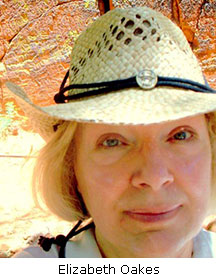Sedona Lit is a series by Dr. Elizabeth Oakes, an award winning poet and former Shakespeare professor. A Sedonian of three years, she will highlight the literature, written or performed, of Sedona, past and present.
 By Elizabeth Oakes
By Elizabeth Oakes
(January 18, 2016)
Max Ernst a poet? Yes, judged by itself, his poetry would make him an important Surrealist literary figure. Although his writing is eclipsed by his art, he had both a visual and a verbal imagination, enabling him to explore the same issues and employ the same imagery in tandem. I have found two poems and two paintings that relate to each other. Importantly, for us in Sedona, they refer to Ernst’s time here.
Ernst mixed the two worlds of art and literature in his personal and his artistic life. He was friends with Paul Eluard and André Breton, two major Surrealist poets. Ernst and Eluard collaborated on two works in the early 1920s, soon after Ernst arrived in Paris, and then again in 1947. One time, for Dorothea Tanning, Ernst’s wife, the connection wasn’t even corporeal. She relates an impression that occurred to her while painting Interior with Sudden Joy in Sedona: “I am here. Arthur Rimbaud, mad poet, is here too, on the blackboard in my canvas. What you see there are notes from his secret notebook. Private, impudent signs.”
Like his involvement with Surrealism, Sedona influenced Ernst. He and Tanning “had a wonderful life there,” Ernst says in Peter Schamoni’s film about him, “It was absolutely marvelous. Words fail me when I try and describe it.” When Ernst first saw Arizona in 1941, he recognized the landscape as one he had already painted. His son Jimmy Ernst describes the moment: he, Ernst, and Peggy Guggenheim (Ernst’s wife at the time) stopped their car near Flagstaff to watch a rattlesnake cross the road, and Ernst “blanched visibly” as he saw his canvases come to life. That, says Jimmy Ernst, “was to change the future of his life in America.”
Entering into a Surrealist poem is like going through the looking glass. It forgoes narrative, often even syntax. It uses the inner world of the psyche as an organizing factor or, perhaps we should say, a disorganizing factor. Things overlap and emotions morph, and things morph and emotions overlap. In his Manifesto of Surrealism (1924) Breton proposes that Surrealist poetry be “pure psychic automatism” independent of “all control exerted by reason, and outside all aesthetic or moral preoccupations.” It is the language of dreams, of the deep unconscious, and of all we try to resist, suppress, or subvert into acceptable channels. It’s difficult to ascertain what Surrealist poets mean, but we can explore what the work means to us.
Ernst’s poem “Hill” is set on Capricorn Hill off Brewer Road where he and Tanning built a home and lived, off and on, from the early 40s to the early 50s:
Seen through the naked eye
This hill is twice as young as its age
For your beautiful naked eyes
She clothes herself with plumes and lead
And a secret, transient sky
But
Viewed through temperament
She takes fire
She encrimsons
Roars
Trombones and booms
In the silences of space
Like a pyramid enraged
Which laughs twice a century
Laughs
With a hazy smile
Laughs
Without rival or reason
Then its terrible love chant
Explodes between two beds of glass.
There are traces of the literal hill here. It is “twice as young as its age,” as they, young at the time, were living on what they spoke of as ancient, even primordial land. However, here we go into a world without boundaries. The action takes place under a “transient” and thus changeable sky. What one sees is dependent on how one views it: through either “beautiful naked eyes,” which suggest innocence, or through eyes clouded by “temperament,” which suggests volatility – the precarious balance between the inner and outer worlds in a nutshell.
 Tanning describes Capricorn Hill as a landscape “so charged that ‘if Wagner had seen this his music would be louder than it is already.’” When they finally had electricity, they played “Stravinsky on 78s. Very loud.” In the poem the hill ”takes fire / She encrimsons,” which could literally be the sunset, but also suggests action, energy, vitality, perhaps close to dangerously so. Then the sound “Roars / Trombones [the word is used as a verb] and booms,” culminating in Ernst’s free association of the hill as a “pyramid enraged, / Which laughs [that is, erupts] once a year,” an allusion, possibly, to a live volcano they saw when they taught at the University of Hawaii the year before, in 1952.
Tanning describes Capricorn Hill as a landscape “so charged that ‘if Wagner had seen this his music would be louder than it is already.’” When they finally had electricity, they played “Stravinsky on 78s. Very loud.” In the poem the hill ”takes fire / She encrimsons,” which could literally be the sunset, but also suggests action, energy, vitality, perhaps close to dangerously so. Then the sound “Roars / Trombones [the word is used as a verb] and booms,” culminating in Ernst’s free association of the hill as a “pyramid enraged, / Which laughs [that is, erupts] once a year,” an allusion, possibly, to a live volcano they saw when they taught at the University of Hawaii the year before, in 1952.
In Wizard Woman, painted in 1941, Ernst foreshadows the poem (if the volcano image in “Hill” is from 1952). In the background along the bottom is a small strip of landscape that looks like Sedona; the base is literal as in the poem. Then, like the hill, the woman “encrimsons” by dressing in a hood and cape of red rock that dissolves halfway down into what looks like flames, like the “fire” of the poem. She towers over a figure who is a cross between a man and a beast. It is not hard to imagine her growing larger and roaring and erupting like a volcano. She already overshadows the landscape. Both she and the hill/woman in the poem are shape-shifters: female, rock, fire, explosion! In Surrealism, there are very few fixed forms, and that is where power lies – and also fear.
 In 1953, around the time of their move to Paris, Ernst painted Colorado of Medusa, Color-Raft of Medusa about an rafting trip he and Tanning took down the Colorado River through the Grand Canyon. To Tanning, the experience was “precious as diamonds” and the canyon “a paradise lost.” To Ernst, it was otherworldly, a blip in time removed from civilization, as shown by his poem “Colouraft”:
In 1953, around the time of their move to Paris, Ernst painted Colorado of Medusa, Color-Raft of Medusa about an rafting trip he and Tanning took down the Colorado River through the Grand Canyon. To Tanning, the experience was “precious as diamonds” and the canyon “a paradise lost.” To Ernst, it was otherworldly, a blip in time removed from civilization, as shown by his poem “Colouraft”:
Amazement grips us
Before your perfumes
Of perfidious asphalt
Of calcified chocolate
Of consummated nights
Of cruel foliage,
Of wet Medusa linen
Colorado
Colour
Raft
Of
Medusa
The structure of the poem is then/now, a common technique. The “then” is the first line and the five ending words. “Amazement grips us” refers to the river trip, which to him is still in the present tense. However, now literally they are in a city with its “cruel asphalt.” Perfume and “cruel foliage” suggest artifice, not the natural scents and the wild plants of the canyon. The static (“calcified”) city contrasts with the movement and excitement of the river.
But Medusa, what about her, she of Greek myth with snakes for hair who turned men who looked upon her to stone? It would be like any Surrealist to put something in a poem, and Ernst includes her twice (and in the title of the painting, Colorado of Medusa, Color-Raft of Medusa, twice), that does not fit realistically in order to assert that no one but the poet can say what belongs or not. However, what if, just what if, there were snakes along the riverbank and what if Tanning’s hair curled in the spray from the raft, and Tanning and Medusa melded in Ernst’s literary and visual and mythic imagination.
After their return and after footage from the trip had been included in Hans Richter’s film 8 by 8, Tanning wonders if “it all showed, alas, that paradise was indeed a somewhere not quite believable , or – can it be – desirable? Were Adam and Eve really chased from the garden? Or did they leave?” Where there is a Garden of Eden, there is also a serpent.
In the painting Ernst places what looks like one, maybe two lizards – reptiles – and a fish head in the red river. What is beneath is very different from the surface, just like the conscious and unconscious levels of the mind. Medusa as beautiful woman (which in the Greek myth she once was) and as gorgon can co-exist in the stream of consciousness that is the Surrealist poet’s métier, and it’s not necessarily a bad thing.
There are some artists who write and some writers who paint, but the Surrealists seem to have reveled in this cross-pollination. As Tanning remembers in Between Lives,
Artists writing, poets painting. A “free” sort of adventure, serious fun without the dedicated preparation, without the drudgery and without too much concern for what other people might find to say about it. If Artaud or Apollinaire – or Henry Miller or e.e. Cummings – decided to draw or even paint, was it only in response to the creative urge? Or might they have wanted a simple change of pace and gesture, as erratic and irresponsible as the capers of birds in air?
Note: The poems “Hill” and “Colouraft” were translated from the French by A.C. Evans and published in the journal Slope in 2002. All quotations from Ernst, Jimmy Ernst, and Tanning are from either Tanning’s Between Lives or the film Max Ernst by Peter Schamoni. Breton’s is from his Manifesto of Surrealism.




8 Comments
To a straight-arrow eartbound guy like me your writing is a bit flighty and vague, but nonetheless interesting, including things I did not know of Max and Dorothea’s doings in Sedona. I got to know them both later through my medical practice, and have a nice graphic piece Max gave me, and am glad they are getting more attention again through Mark Round’s brief exhibit at the Art Barn, and he signage along the walkway between uptown and Tllaquepaque. Dick G.
Thank you for your comment, Dr. Griesenbeck. I plan to write a column in the future based on people who remember Ernst and Tanning in Sedona. Perhaps we can chat or correspond by e-mail. They are an integral part of Sedona’s history, and, as you say, deserve to be honored.
The boundaries of human expression, like the boundaries of nations are created by us. Poet, painter, philosopher–a free person moves seamlessly from one to the next without being constrained by artificial designations externally imposed. Thank you for this reminder.
So very well said, Andrea! Thank you for responding and for adding to the column!
Very educational… thanks Libby
It was educational for me as well, Liberty, as I hadn’t known about Ernst as a Surrealist poet —
Thank you for responding!
Delightful article!! It’s wonderful to learn more about the great minds who have passed this way. Thank you, Libby! I look forward to read more of your scholarly investigations into the literature of Sedona’s past very soon!
Sharron, Thanks! There certainly is a lot there to find out — especially about the connection of the writing to the painting —